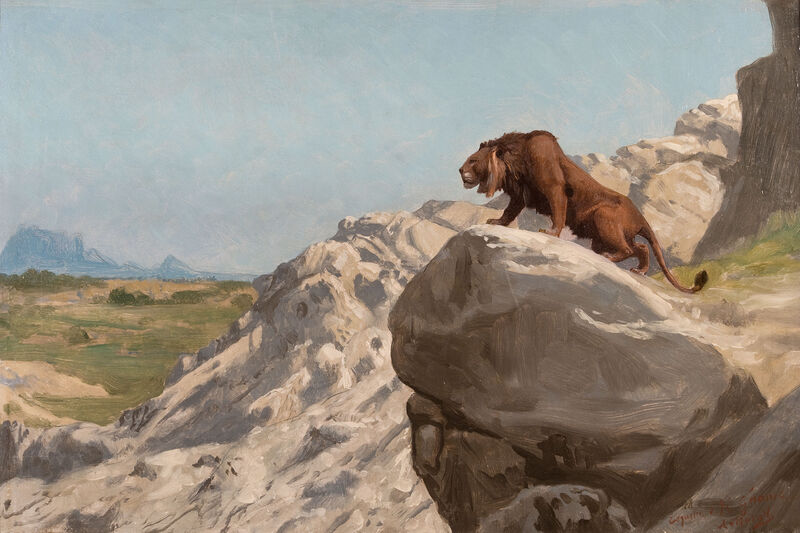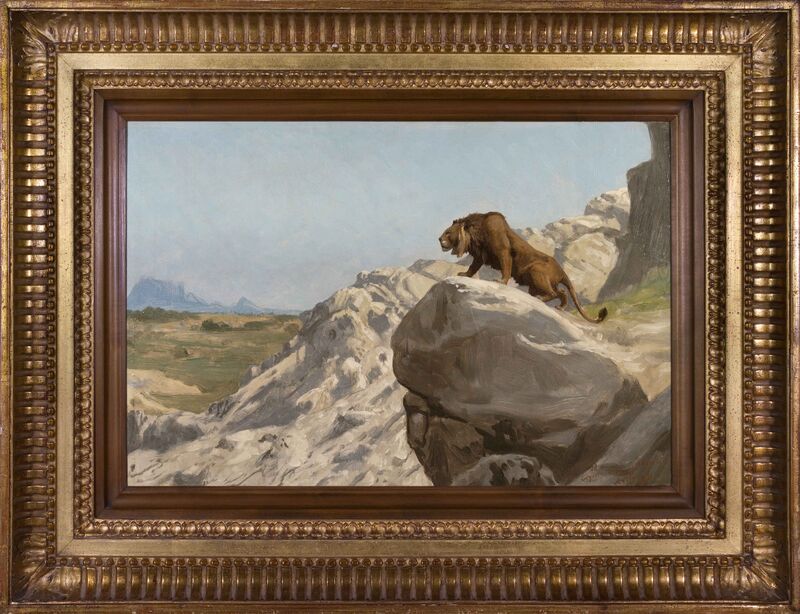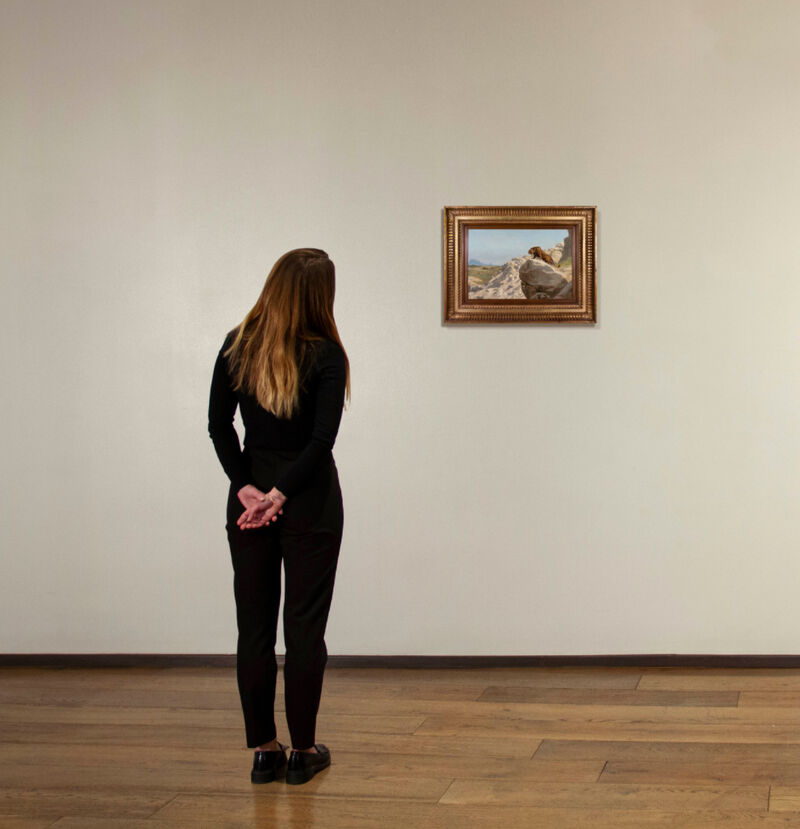Jean-Léon Gérôme
(French, 1824-1904)
Lion aux Aguets
oil on canvas
29.2 x 42.4 cm (11½ x 16¾ in.)
signed and inscribed 'Esquisse J L Gérome/Aimé Morot' (lower right)
M. Poncelet, Paris.
G. M. Ackerman, Jean-Léon Gérôme, Monographie et Catalogue raisonné, Paris, 2000, p. 372, no. 529.2, illustrated (black and white) (with dimensions incorrect)
Laurence des Cars, Dominque de Font-Relaux, and Edouard Papet, eds., The Spectacular Art of Jean-Léon Gérôme (1824-1904), Los Angeles, 2010, p. 200, illustrated (colour)
Paris, Galerie Tanagra, Exposition Gérôme, sculpteur et peintre de l'Art officiel, 1974, no. 25
This painting has been examined by Dr. Emily M. Weeks, who confirms that Lion aux Aguets is an original oil sketch executed by the French artist Jean-Léon Gérôme (1824-1904), with no intervention or additions by another hand (save the inscription). It will be included as such in the forthcoming revision of the artist’s catalogue raisonné, thereby altering the determination of Professor Gerald Ackerman, author of the 2000 edition (no. 529.2).
Price:
£150,000
More artworks by Jean-Léon Gérôme ▶
Additional Notes:
The lion is on the watch, on a high ledge over some desert place, looking for prey in a vast and arid landscape. He carries a lot of dignity on his taut shoulders: seeming to be both alert and patient, and ready to bound down and away if a prospect comes into sight. It is hardly imaginable that Jean-Leon Gérôme had ever seen a lion on any of his trips through the deserts of North Africa and Asia Minor. The lion lives and hunts in grass plains where he can find grazing game, seldom in a desert or on a desert mountain. Furthermore, the lion had been, in Gérôme's time, long absent from North Africa, persisting only in Sub-Saharan Africa and in one province of north-west India. Nonetheless, Gérôme painted many compositions of lions with desert settings. He was evidently fascinated by the desert lions of his imagination, who lived a romantic life maintained by almost desperate hunting for food and water.
Gérôme had two personal connections with lions, the first was his given names, Jean-Léon; according to 19th century practice, the middle name was the most important, the one used by his family and friends. He even painted two puns on the name, one a wonderfully sketched lion with a strong personality stretched out on a rocky ledge-perhaps at the mouth of a cave-with a heraldic shield placed in the upper right corner. The device in the shield is undecipherable but the motto on the banner underneath is clear: Nominor Leo, Latin for 'My name is lion' (1885, Musée Garret, Vesoul). The other is a depiction of St Jerome asleep in a cave, his head pillowed against the famous lion that he had befriended, also asleep (1877.whereabouts unknown). It is a pity that the painting is lost because the Saint Jerome is one of the very few male nudes painted by Gérôme, an especially fine study of an aged if hardy physique.
The second connection with lions, probably prompted by the association with his name, was Gérôme's love of the beasts; for a while he owned one as a house pet. He sketched the big cats in the zoo and followed circuses around just to study their lions. Indeed, it was from a circus that he bought his pet lion, an older animal, no longer vigorous enough for the performance routines. Although docile, the lion was not a completely tamed animal. One morning when a servant took the morning cup of coffee upstairs to Gérôme's bedroom, he found the bed not only empty, but untouched. He quickly descended the steps to the downstairs studio to see if the master had worked all night and had fallen asleep in the studio. He knocked at the door and was answered with shouted instructions: 'Don't open the door, and get the lion trainer.'
When the trainer arrived at the house, he cautiously entered the room and found Gérôme cramped within the lion's cage, while the lion, in a bad temper, ranged around the room and menaced his owner. The tamer cowed the lion into a corner; Gérôme came out of the cage; the tamer induced the lion into the cage and locked it, and all was well. Gérôme had spent the night in the cage. Even so, the lion was a beloved animal, as we can see from the affection with which Gérôme drew and painted him in numerous poses.
Gérôme knew the desert well from his many adventurous visits to the Near East. He himself had organized large safaris for himself and his friends. Using Cairo as a base, they usually toured up the Nile; into El-Fayoûm; and then from Cairo over the Isthmus of Suez into the Sinai peninsula, and then from Aqaba, up the Wadi al-'Arahba: an itinerary that was followed, with some variations, at least four times. On the way Gérôme continuously made moderately-sized oil-on-paper sketches of the landscape, sometimes even while riding camel back. Only a few of the hundreds of sketches that he must have made are known, but even some of them can be recognized as furnishing the backgrounds for more than one composition.
In the landscape of the sketch, Lion aux aguets, Gérôme demonstrates another of his specialities: he was great at painting rocks, an activity that Winslow Homer once advised a younger painter to save for his old age; for lacking easy-to-capture geometrical shapes, rocks had to be made convincing by way of pure drawing skills and exact colour values, without much help from linear perspective. Gérôme's rocks are already convincing in shape and placement in this preparatory sketch. The reflected light on the shaded side of the podium rock is especially fine even if loosely painted. The major rocks in the finished version of the painting, owned by the Cleveland Museum, are almost the same; admittedly more finished, they seem not more convincing, but more decorated. Most of the preparatory solving of problems had been taken care of in the sketch (fig. 1).
You may also like:
Enquire Now
Fill in the form below and we will respond as soon as possible.
Make an offer
Fill in the form below and we will respond as soon as possible.



